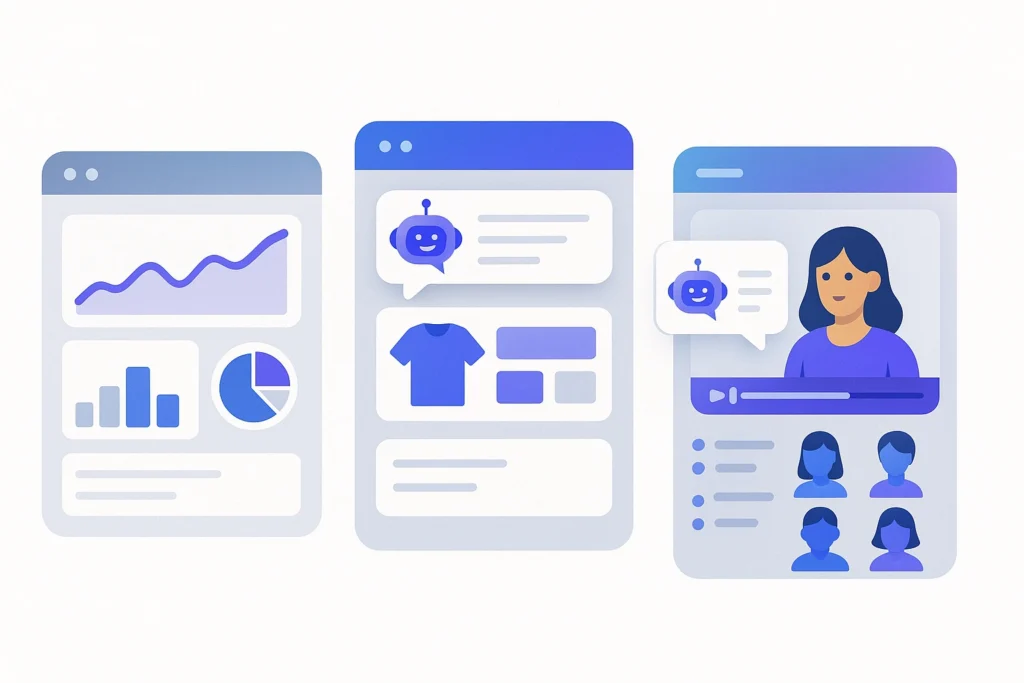Top Use Cases for AI Tools in SaaS, E-commerce & Education

AI tools are no longer just an advantage — they’re a necessity. In sectors like SaaS, e-commerce, and education, AI is powering everything from automation to customer experiences to strategic decision-making. Businesses in these industries are integrating AI to improve efficiency, scale operations, and offer users hyper-personalized experiences.
In this expanded blog, we’ll take a deep dive into how AI is transforming work across these sectors in 2025. Whether you’re a tech founder, digital marketer, educator, or SaaS product lead — this guide will show you where AI makes the biggest impact.
💻 AI in SaaS: Smart, Scalable, Streamlined
SaaS companies are built around agility and data. With users demanding real-time personalization, instant support, and smooth onboarding, AI tools are the unsung heroes behind modern SaaS growth. Here’s how AI is reshaping the SaaS landscape:
1. Automated Customer Support
With AI chatbots like Tidio, Crisp, or Intercom AI, companies offer 24/7 instant support — answering common queries, guiding users, and escalating issues when necessary. This reduces support tickets and boosts customer satisfaction.
2. Predictive Analytics
AI tools like Mixpanel AI or Pendo analyze user behavior to predict churn, identify power users, and recommend features proactively. Teams can optimize product roadmaps and improve user engagement based on data.
3. AI-Powered Personalization
Tools like Mutiny or Optimove AI help tailor in-app content, email workflows, and dashboard experiences based on usage data and user intent — delivering dynamic content in real time.
4. Onboarding and Training Bots
No-code AI platforms like UserGuiding AI or Whatfix personalize onboarding by showing tooltips, walkthroughs, and video explainers tailored to a user’s role or behavior.
5. Code and Content Generation
Dev teams use tools like GitHub Copilot to speed up development, while marketing teams rely on Jasper, Copy.ai, or Writesonic to produce blog posts, guides, and help docs.
➡️ SaaS businesses using AI reduce churn, increase product usage, and spend less time on manual tasks — unlocking scalable growth.
🛒 AI in E-commerce: From Browsing to Buying
The e-commerce boom is being turbocharged by AI. With customer attention spans shrinking and competition rising, online stores use AI to increase conversion rates, reduce returns, and streamline operations. Here’s how:
1. AI-Powered Product Recommendations
Amazon-like personalization is no longer exclusive to giants. Tools like Clerk.io, Segment, and Vue.ai use behavior tracking to suggest the right product at the right time — boosting cart value.
2. Visual & Voice Search
Apps like Syte and Snap Vision use image recognition to let users search with photos instead of text. Others, like Google Lens, offer seamless voice and AR integration.
3. Chatbots for Sales and Support
AI-powered assistants handle FAQs, return requests, product discovery, and even upselling. Popular tools include Giosg, Drift, and Tidio for Shopify.
4. Inventory and Demand Forecasting
AI tools like Inventory Planner or Cogsy predict which items will sell out, helping retailers plan smarter and avoid overstock or missed sales.
5. Dynamic Pricing and Ad Optimization
Platforms like Prisync and AdCreative.ai use AI to adjust product pricing based on competitor data, seasonality, and customer interest. Ad creatives are tested and optimized automatically.
➡️ AI makes e-commerce smoother, more efficient, and more profitable — from search to checkout.
🎓 AI in Education: Personalized, Accessible, Scalable
AI is bringing personalization and scale to education like never before. From online tutors to fully adaptive learning systems, here’s how schools, educators, and edtech startups are using AI to empower students and streamline teaching:
1. Adaptive Learning Paths
AI platforms like Knewton, Squirrel AI, and Century Tech analyze how students learn, then adjust the curriculum in real-time. Learners receive content suited to their pace and style.
2. AI Tutoring Assistants
Apps like Socratic by Google, Quillionz, or Khanmigo answer student queries, explain concepts, and provide examples. These tutors are available 24/7 and adapt over time.
3. Automated Assessments and Grading
Teachers can now automate quiz creation, feedback, and essay evaluation using tools like Gradescope, Kiteworks AI, or even ChatGPT.
4. Multilingual Support and Accessibility
With AI tools like DeepL, Speechify, or Otter.ai, students get real-time translation, closed captions, and audio transcriptions — making content more accessible.
5. Content Creation and Summarization
Educators use tools like Notion AI, Mindgrasp, and Tome to build lessons, generate quizzes, summarize reading materials, and build interactive presentations.
➡️ AI in education makes learning more inclusive, efficient, and engaging for everyone.
📌 Bonus: Use AIToolsfied to Explore AI Tools by Use Case
AIToolsfied is the go-to hub for discovering AI tools tailored to your industry. Here’s what you can do:
- Browse over 6,000+ tools sorted by niche, use case, or category
- Submit Your Tool and get seen by the right audience
- Explore Pricing Plans for featured placements
- Request a Custom Plan if you have unique needs
🧠 Final Thoughts
AI is no longer just about automation — it’s about intelligence, personalization, and agility. In SaaS, it drives smarter products. In e-commerce, it improves buying journeys. In education, it makes learning more accessible. Regardless of the sector, AI is shaping the future of work and innovation.
By understanding these use cases and integrating the right tools, your business or institution can deliver faster, smarter, and more impactful experiences.

